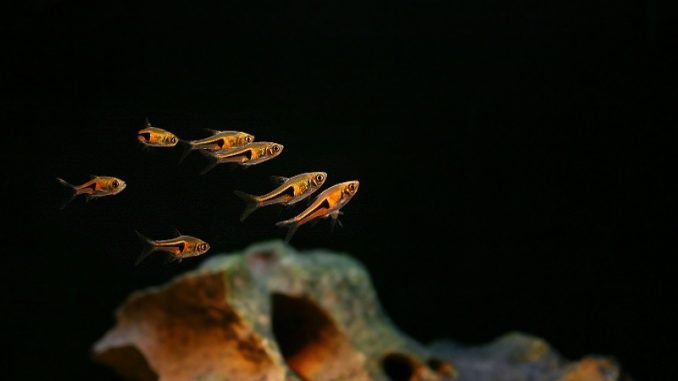
The rasbora fish group is a genus of 84 schooling freshwater species of fish in the family Cyprinidae. Native to Southeast and South Asia, and China, rasboras are found in a variety of colors and patterns.
Rasboras are popular amongst aquarists because the fish come in striking colors and shimmer in the light. A shoal of five or more rasboras is a beautiful sight.
TABLE OF CONTENTS
Rasbora Facts & Overview
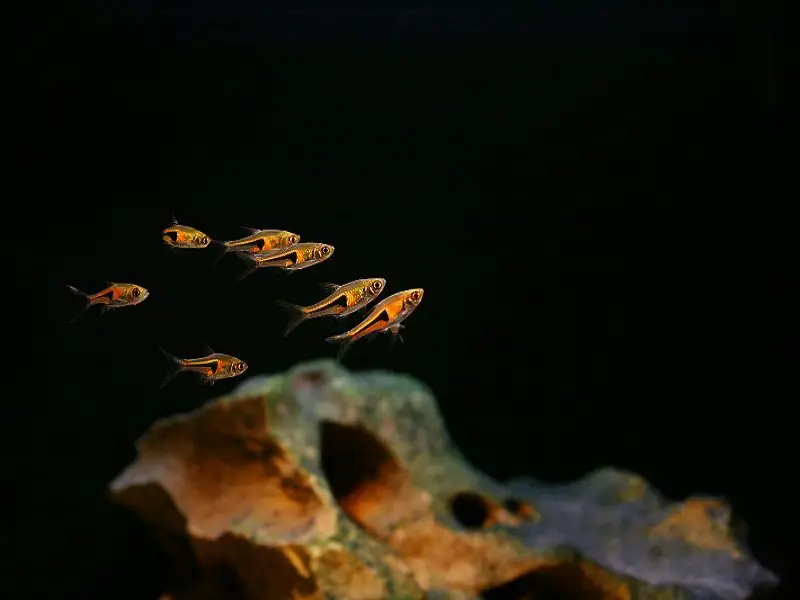
| Scientific order: | Characidae |
| Common names | Rasbora |
| Distribution: | China, South Asia, and Southeast Asia |
| Size: | Up to 6 inches |
| Life expectancy: | 5–8 years |
| Color: | Various colors, including red, black, orange, blue, silver, gold, and green |
| Diet: | Omnivore |
| Temperament: | Peaceful |
| Minimum tank size: | 10 gallons |
| Temperature: | 72–81°F |
| pH: | 4.5–7.8 pH, depending heavily on the variety of rasbora |
| Hardness: | 2–15 dGH |
| Care level: | Easy |
| Breeding: | Egg-layer |
Origin & Distribution
The name rasbora was introduced as a fish name by Francis Buchanan, a British zoologist, in Buchanan’s published book “An Account of the Fishes Found in the River Ganges and its Branches.” The first known use of “rasbora” was in 1931.
Today, rasboras are found in China, South Asia, and Southeast Asia.
Types of Rasboras & Appearance
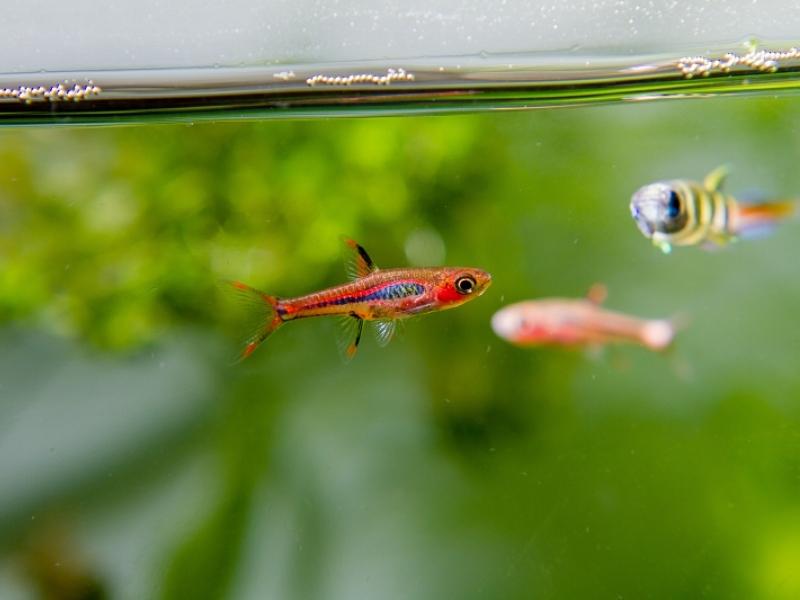
There are approximately 84 types of rasboras, according to FishBase. The main types of rasboras are:
- Harlequin rasboras: Tapered tails, diamond-shaped bodies, orange-colored with a black wedge. Peaceful, with low care needs.
- Clown rasboras: Pinkish-orange bodies with black spots, prefer groups of eight to ten. Require acidic water of around 4.0 on the pH scale.
- Dwarf rasboras: Ruby red bodies with black spots and splashes of orange. Also known as pygmy rasboras. Prefer low pH levels and high acidity.
- Galaxy rasboras: Deep blue base colors with orange fins and pearl-colored spots. Suitable for beginners. Prefer a neutral pH and temperatures between 72 and 79°F.
- Scissortail rasboras: Streamlined bodies with shimmering silver scales and forked tails. Black and white stripe on each side of the tail. Strong swimmers, prefer open space.
- Blackline rasboras: Gray, transparent bodies with a thin, black stripe that runs from the tail to the gill plate. Inhabit polluted waters in the wild. Require soft water with a neutral pH.
- Lambchop rasboras: Red, orange or yellow bodies with a black, wedge-shaped mark that resembles a lamb chop. Easygoing and adaptable to most conditions. Do best in groups of 6 or more.
- Chili rasboras: Pink and red bodies with two lateral stripes of dark black and bright red. Timid, can take a while to adjust to their environment.
- Phoenix rasboras: Ruby-red bodies with spots of black, surrounded by yellow, red, and orange, creating a fiery, phoenix-like appearance. Social, need to be kept in groups to feel safe.
- Brilliant rasboras: Shiny silver bodies with a thin black stripe from the mouth to the tail. Can live in waters with a pH as low as 3.0.
- Least rasboras: Tiny fish with silvery-blue bodies and a black and yellow stripe from the gill plate to the tail. Also called the exclamation point rasbora.
Rasbora Behavior & Compatibility
Rasboras are peaceful, sociable fish that enjoy one another’s company. Some species of rasbora are timid and spend a lot of time hiding between the plants in the aquarium. Other species swim quickly and dart around the tank. It takes time for some rasboras to adjust to a new environment.
Shoals of rasboras move in groups, and many species of rasbora show their most impressive behavior and brightest colors in groups of eight or more.
Rasboras are mid-dwelling and spend most of their time swimming around the middle of the tank. Although rasboras rarely stray to the bottom of the tank, the fish will sometimes leave the middle-ground territory to explore plants in the tank.
Tank Mates
Rasboras are peaceful fish that don’t try to annoy or bully other fish. You can house rasboras with most non-aggressive species of fish. Avoid fish that are more than double the size of the rasboras, such as cichlids, because these large fish might view rasboras as a snack.
Some species of rasboras are timid and shouldn’t be housed with boisterous fish, like bettas and clown loaches.
Some small, peaceful fish that get on well with rasboras are:
- Danios — A lively, hardy family of fish, danios are small, beautiful fish that are easy to care for. Danios are peaceful and non-aggressive and don’t like to cause trouble or bother other fish. These schooling fish should be kept in numbers of six or more.
- Dwarf gourami —The dwarf gourami is so peaceful that the fish allows itself to get bullied by other fish. Dwarf gouramis are ideal tankmates for rasboras because both fish species will leave each other alone. Growing up to 3.5 inches in length, dwarf gouramis don’t get much bigger than rasboras.
- Corydoras —Otherwise known as cory catfish, corydoras are 2.5 inches when fully grown, so they’re not big enough to cause problems in the tank. Corydoras forage for food in the substrate and spend most of their time at the bottom of the tank. These fish are peaceful tank mates for a rasbora.
- Guppies — Guppies are some of the most beautiful small fish available, growing up to 2.5 inches in length. With peaceful natures, guppies require the same water conditions and tank setup as rasboras. Guppies are schooling fish, and you should buy at least ten fish for your tank.
- Tetras — Neon tetras and cardinal tetras are both suitable tank mates for rasboras. These tiny fish rarely exceed 1.5 inches in length. Like rasboras, neon tetras and cardinal tetras prefer the middle of the tank, but these fish aren’t aggressive or territorial. You should get a school of six to ten tetras for your tank.
- Non-fish tank mates — Snails and shrimp, such as mystery snails and cherry shrimps, will clean up after your fish and add diversity to the tank.
Before considering other types of fish for your tank, make sure your rasboras have enough fish of their own kind to live with. Rasboras are schooling fish, preferring to swim in groups of at least eight. These fish feel comfortable in large groups and enjoy each other’s company.
Male vs. Female Rasboras
Distinguishing the difference between male and female rasboras is easy. Males and females are similar in size, but males have more coloring on the caudal and dorsal fins than the females. Male rasboras with a black dorsal patch, such as Harlequin rasboras, have a rounder dorsal patch at the tail end and an extended tip compared to a female’s dorsal patch.
Females have deeper bellies than males, especially during the breeding season. Males and females have similar temperaments, and males are rarely more aggressive than females. Females and males require the same care in a home aquarium.
Rasbora Tank Setup
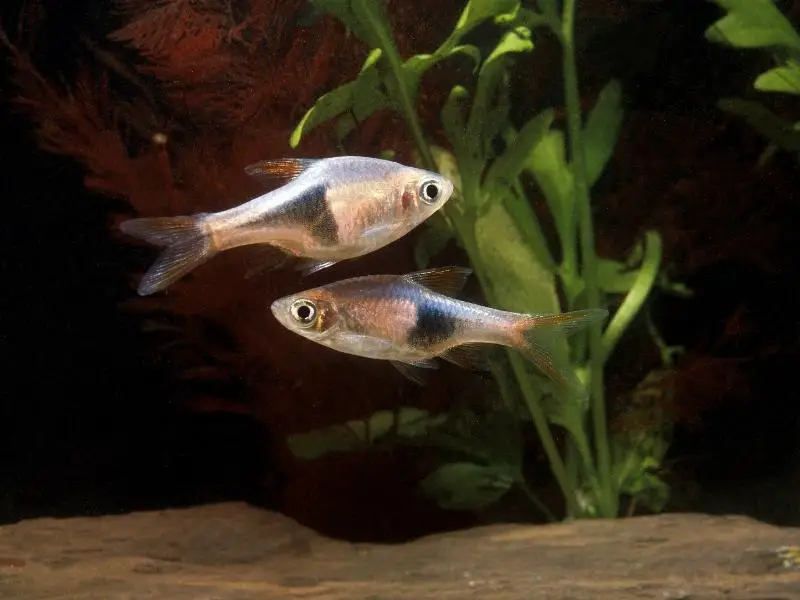
Some rasboras are easier to care for than others. For instance, lambchop rasboras have low care needs because these fish adapt well to their environments. Harlequin and galaxy rasboras are also easy to care for and suitable for beginners. Clown rasboras, dwarf rasboras, and brilliant rasboras require specific water parameters, so these fish have more demanding care requirements than other rasboras.
You should replicate your tank’s environment depending on the fish’s exact habitat. Temperature and pH are two of the most important parameters to get right in a rasbora’s tank.
Tank Size
The minimum tank size for rasboras is 10 gallons. A 10-gallon tank gives rasboras enough room to swim as a shoal. The bigger the tank, the more decorations, plants, and hiding places you can include.
Water Temperature, Hardness, & pH
Rasboras are tropical fish that are used to warm waters. Set your tank’s heater between 72 and 81°F to ensure your rasboras are comfortable in their environment.
Some rasboras, like clown rasboras and dwarf rasboras, need a pH of 4.5–7.0. Other rasboras, like galaxy rasboras and harlequin rasboras, need a neutral pH of 6–7.8. Lambchop rasboras adapt to their environments, and pH is less of an important factor for these fish. Extreme acidity or alkalinity is dangerous for rasboras.
Most rasboras require a water hardness of 2–15 dGH. These fish do best in soft water, between 4 and 8 dGH.
Substrate & Decoration
A sandy substrate best replicates the rasbora’s natural habitat. Because rasboras aren’t bottom-dwelling fish, using this type of substrate isn’t imperative. Gravel can be used in place of sand.
Your tank should have open swimming areas and places for the rasboras to hide. These fish spend most of their time in open water, but they enjoy hiding behind plants. Some of the best plants for rasbora tanks are java fern, duckweed, java moss, and Amazon sword.
You don’t need specialist equipment for a rasbora tank. Aquarium lights, a filter outlet, and a heater are the three most important tank features. Rasboras are used to slow-flowing currents, which a filter outlet can provide.
Rasbora Care
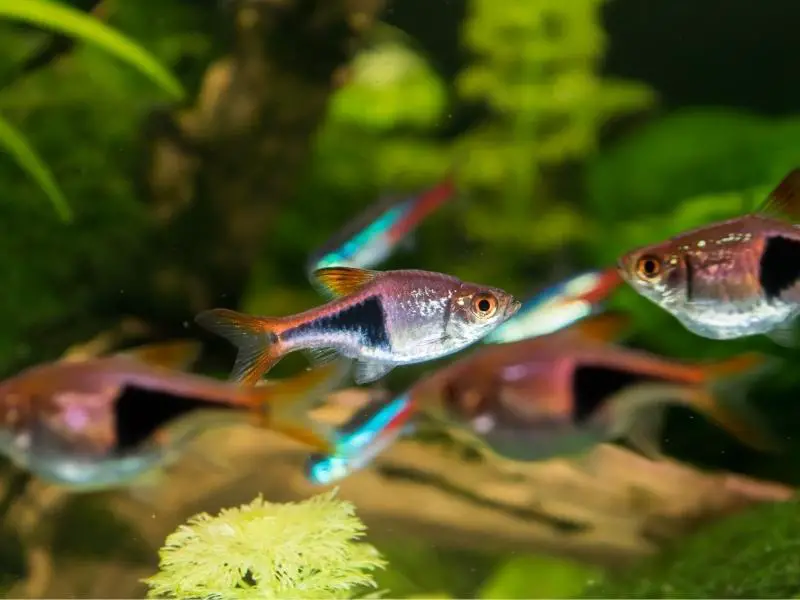
The most common rasboras, including Harlequin and Chili rasboras, are easy to care for as long as the tank parameters are spot-on. Rasboras are hardy fish that rarely fall ill when housed in the right environment.
Diet & Feeding
Rasboras are omnivores and enjoy a wide range of foods in their diets. Because rasboras have small mouths, you shouldn’t feed the fish large food particles.
In the wild, rasboras eat small eggs, insect larvae, and plant detritus. As opportunistic eaters, wild rasboras eat whatever they can find.
Feed rasboras store-bought foods, such as flakes and pellets, that are suitable for small fish. You should vary your feeding to keep your rasboras interested. Live or frozen foods, such as insect larvae, daphnia, or bloodworms, are good options to consider. These foods are similar to what rasboras find in the wild.
Rasboras need food twice a day. Feed rasboras enough food for the fish to finish within two minutes. Remove any leftover food once the fish have finished eating.
Disease
Rasboras rarely fall ill, but these fish are still prone to some of the most common aquarium diseases, including the following:
Ich
Characterized by white spots all over the body, ich is a parasitic disease affecting the scales and fins. Ich is caused by a parasite called ichthyophthirius multifiliis, which attaches to the fish’s body and produces itchy patches that look like grains of salt.
A fish with ich will hide, breathe rapidly, and rub its scales against hard surfaces. Ich can be treated by increasing the water temperature by two degrees and using anti-parasitic medication.
Fin and Tail Rot
Fin and tail rot is a common, preventable bacterial disease that is caused by poor water conditions. This disease causes the tissues in the fish’s fins and tail to rot from the edge to the base. A discolored fin or tail, a part of the fin or tail wearing off, and lethargy are all signs of fin and tail rot.
You can treat this disease by changing the water and vacuuming the debris frequently, adding aquarium salt to the water, and using antibiotics like Amoxicillin.
Dropsy
Dropsy causes the fish’s abdomen to swell due to a buildup of water. If your fish is swimming in an irregular pattern and looks more bloated than usual, you have a dropsy problem in your aquarium. Poor nutrition and high levels of nitrate or ammonia cause dropsy.
To treat dropsy, quarantine the affected fish and add 1 tablespoon of salt per gallon of water to the quarantine tank. Perform a water change in the original tank.
Pop-Eye
Caused by a bacterial infection, pop-eye is a condition that causes one or both of the fish’s eyes to swell. Pop-eye is caused by fighting between fish, poor water quality, or an infection.
Treat pop-eye by feeding the fish a nutritious diet, with antibiotic food recommended by your pet supplier. Quarantine the fish in a tank with optimal water conditions and add up to three teaspoons of Epsom salt for every five gallons of water to reduce swelling.
Breeding Rasboras
Rasboras are easy to breed, and these fish have been known to breed without assistance from an aquarist.
You’ll need a separate breeding tank to breed rasboras. This tank should contain broad-leafed cryptocoryne plants, which rasboras lay their eggs in.
To breed a pair of rasboras, follow these steps:
- Place a healthy, well-conditioned male in the tank with a female. Wait until the next morning, when courtship will begin.
- The male fish will dance and flare its fins to attract the female. Both fish will swim together until they move underneath one of the leaves of the cryptocoryne plant.
- The female will deposit several eggs. The pair will emerge from underneath the leaf to court again, then return to the same plant to deposit more eggs.
- A healthy pair will deposit up to 100 eggs. Remove the parents when breeding has finished to prevent the parents from eating the eggs.
- Within 24 hours, the fry will hatch. Feed the fry on the third day with liquid fry food. Wean the fry onto baby, commercial, ground fish food, and brine shrimp.
Rasboras are sensitive to water changes, so you should keep the pH, temperature, and hardness of the water consistent in the breeding tank to prevent the fish from becoming stressed.
Should You Get a Rasbora for Your Aquarium?
You should get a rasbora if your home aquarium has stable water temperatures, lots of nooks and crannies for exploration, and small, peaceful tank mates for a rasbora.
You shouldn’t get a rasbora if the tank’s water conditions are fluctuating, or if your home aquarium houses large fish that might eat the rasboras.
Rasboras are hardy and beautiful to look at, which makes them ideal for fishkeepers of all experience levels.

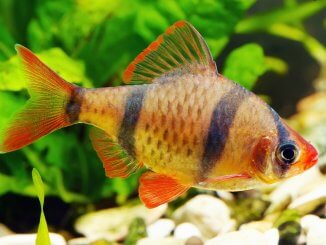
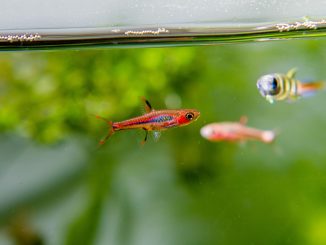
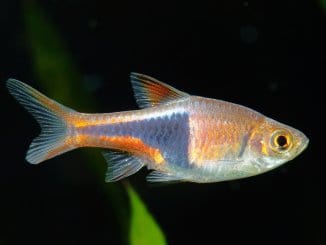
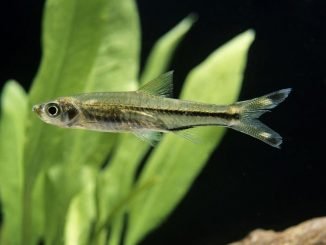
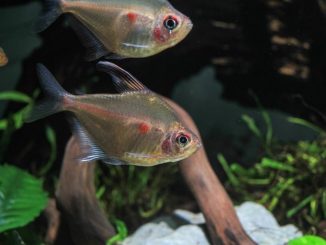
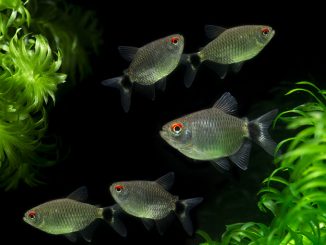
Be the first to comment